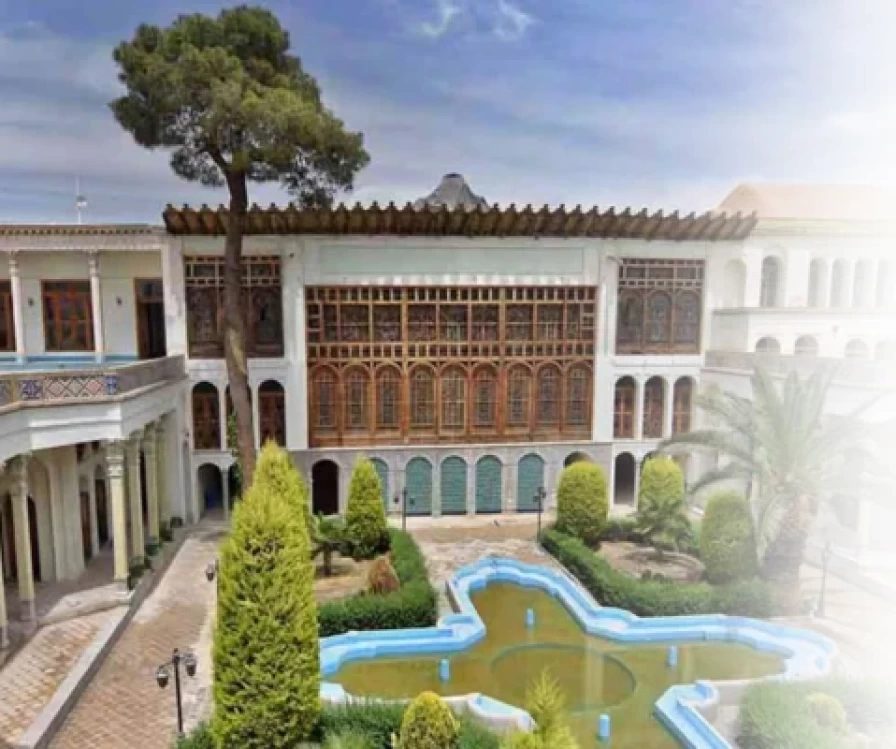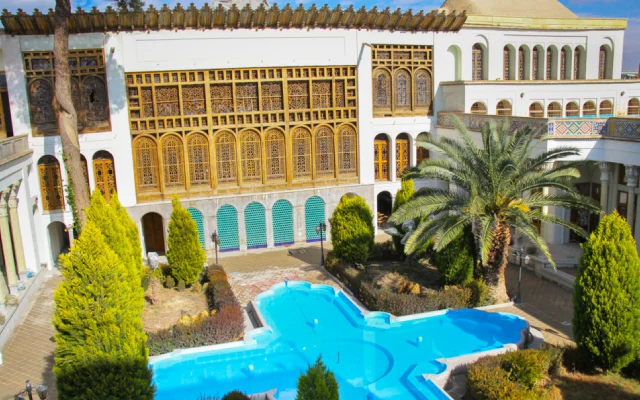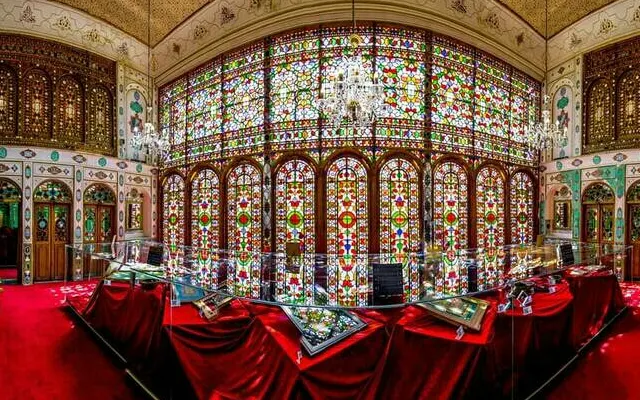
Moshir- al mulk house , walking in the corridors of history





Moshir- al mulk house
In every corner of Iranian cities you can find a beautiful traditional house which most of them were made I Qajars era. Unfortunately because most of Iran is covered by deserts and the rain and precipitation is too low in most parts of the country even in Persian gulf and the only exception is around Caspian sea, the prominent percentage of Iranian lands are covered by sand and silt and because of this the only source for making buildings are made from mudbricks against stone and baked bricks. This lack made all the house, buildings, citadels and castles are susceptible to ruining and most of the old buildings which are made before 500 years ago ruined because of rains, storms and other natural forces and today you can find just a dune of sand or silt and cobles which are used to made the main structure but today most of them are changed to a mass of ingredients used many years ago. Even all the stone structures during Achaemenes era were covered by sand until the day the archaeologists in earl 20th century started to recover the remaining of those stone structures and today you can find them in form of huge stone structures like Persepolis and Pasargadae in south of Iran . So most of the traditional houses are made from natural ingredients like clay, sand and silt return to late safavid, zand and Qajars dynasties. Because in old times people used the local natural ingredients like sand, rock, stone, clay or wood or other natural resources, Iranian people used clay and sand to make mudbrick to use in construction. Unfortunaely clay and silt washes in the rain and because lack of consistency in this material, most of the mud and clay made bricks destroy trough time and raining. Because of this most of traditional old fashion houses were destroyed after abandon by owners by rain and other natural forces. So the remaining traditional houses are like gems between modern cities and many of them today changed to hotels, museums, galleries and other functions. Preserving old houses is a must for new generation and should be followed by private and governmental cultural heritage organizations.
According to a very basic rule in Islam male and female have to be separated after a boy or girl is full grown. So all the public places in Islamic countries are separated to men and women and this rule should be followed in a very strict way. A man never have the chance to visit a women without Hijab and all the women and girls after full grown have to cover their body by a piece of cloth known as “Chador” from head to toe. In normal situation the color of chador is in black and in some parts of country mostly in south women cover even their face too. This mask cover names “Burka” is under use even today, but new generation for hygienic matters refuse to use it even they are strict believers in basic rules of Islam as Hijab. Because of this the spouse and daughters of a man have to leave in hade and because of this rule all the homes and private places are divided to two different space name as Birooni or exterior and andarooni or interior part of a private house or place. The space which interconnect these two places known as octagonal or “Hashti” is the place which the people inside make decision to have Hijab or not. This octagonal is different in form and shape and ornaments used and each house has unique design to make Hashti or octagonal and most of octagonal end to the yard.
On the door of gate of house there is a door knob which too hanging hammers are made and nailed to the wood lumbers of the door. One of them dedicated for male and the other for the female guests visiting the house. The male hammer has a bass sound and the other for female has a lower frequency sound like the female voice which is lower in frequency. So if a guest hammer the male one the sound of the hammer is more bass and the owner understand that a man is behind the door in octagonal or hashti so the owner wear her chador and after that show herself to the guest instead if the sound of the doorbell or female hammer reach the owner she understand that a woman is hanging the doorknob and there is no need to have the Hijab. In this dynamic system people of our country lived for1400 years and by separating their homes and private places thy followed the very basic rules of Islam in their daily life. Each door knob is different in shape and form and each one is unique between others. Today most of the old houses have electric components to inform the owners and unfortunately most of the door knobs are forgotten. After “hashti” or octagonal space you can enter the interior under supervision of the owner and in a very strict control way.
In all traditional homes, big or small there is a shallow pool in the center and all the rooms which have different functional rooms and spaces are located around that pool to have enough water in their daily life. This pool add more beauty to the house because of reflection of the building image on the water and add more humidity because of evaporation. It should be shallow because water is scarce in Iran and for the hygienic matters it is better to change water frequantely. This pool is filled by water of a water reservoir or by Qanats which is a very sophisticated water supply and complicated subterranean channels and interconnected wells which gather subsurface deep water and brings out the water in lower places which named “Payab” or “Haranje”, the water which is flowing from Qanat runs to very complicated watering distribution system and each house has a share of the water. In some occasions this water is supplied by a spring in rare occasions and mostly this water supplied by Qanat system in desert cities.
In all traditional houses especially in very reach families there are many rooms each dedicated for some functional and occasional functions and the best one is belonged to the quests. This space which is open in many homes or covered by a wooden interwoven stricter known as “Orocy” named as “Shah neshin” or the place of shah or king in in the center of the structure and mostly ornamented by mirrors, stucco, paintings, gold color motifs an lamps and jars are hanging from the ceiling, this is the best place or most ornamented place in every traditional house you can find past and today. “Orocy” or sash window is an interwoven webs of woods locked together and normally there are many different colorful pieces of glass inside.
In every house you will find many patios and galleries according to the desire of the owner and art of the architect. These galleries and patios are unique in each house and shows the art of the architects and other artists worked in different part of the country. In all houses the washrooms and toilets are situated in the yard and open space to prevent bad smell comes to the rooms and closed spaces. To use pull water some copper made special pitchers to wash themselves. This pitcher names as “Aftabe”, today some old fashion living people use the plastic ones instead of copper made. There is a kitchen in all houses named as “Matbakh” and there is a basement in all homes to escape from hot summers and rest in cooler place and because this basements have air-conditioned atmosphere and cooler in summers they used this space for preserving and keeping foods and beverages and even pickles in winters and fruits or grains in summer time. Other rooms are interconnected and separated by wooden doors and in base of each door there is a piece of wood not too high which is used to prevent dust penetration and note the guest to remove their shoos before coming home. Because walking through a home or private space which is a carpet is spread on the floor and covered by a cloth is a great seen in Iran and at last to prevent snakes and scorpions or other insects to have the chance to come to the rooms. In most traditional houses there is no bath and all people used public bath but because they paid more they had better service. The best place to service elite people was again “Sahaneshin” as the place of kings which is a metaphor for best place of the room. Iranian people love to have guests and they behave guests like the kings. So it is obvious shahneshin belonged to dear guests and it was the most beautiful part of the building.
In some homes there is a passive air condition system known as “Badgir” or wind tower or wind catcher. This tower make a barrier against hot wind and conduct wind to the channels end to a basement which established a shallow pool exactly to the exhaust of wind catcher. By striking the hot air to the water surface, the water start to evaporate and according to a very simple dynamic rule the air temperature drops down and the air humidity rises and this cool and humid air runs to channels which end to the rooms and by this system the temperature of the rooms drop down and the weather or air conditioned dramatically and passively in hot weather of home deserts to let the people tolerate the summers and live in better condition. Interestingly this system needs no energy or electricity to run and there is no need to winterize it because by closing the manifolds by a piece of wood or stone or even ceramic the system is closed simply and properly and changed from winter mode to summer mode without any confusion.
In many houses there is a shallow well to supply water in winters and today most of those wells are closed and filled by soil and mud to prevent kids falling accidentally. In some big and elite houses there is a stable for horses and mules and a separate place for people who serviced the house and guests as servants of old days. One of the other interesting places in basement of the old fashion houses is an space like a bare cave dug through one of the walls of the basement and it was like a whole in the wall and not covered by any handmade covering from bricks to ceramics, even you can find trace of hammers on the bared compacted soil in the walls of the whole. Our ancestors learnt by experience if you put fresh foods inside this space the ambient of the cave is more stable in winter and summer and the weather inside temperature not fluctuate too much in normal situations. In winter the weather inside the cave is warmer and in summer it is cooler comparing the outside hot and cold weather and because the soil inside is not covered the humidity percentage is high enough to well preserve the fresh foods and perishable materials like milk, meat and dairies or even vegetables and pickles which preserved in potteries and ceramic containers in winter. By this genius act our ancestors preserved perishable materials without having a fridge or ice for longer time. Having a shallow pool in basement drops down the temperature and add more humidity in hot summers and lets the people who slept in the basement in the afternoon have more pleasurable time in hot summers of country. In most places they had water fountains in the shallow pools in basements which added more humidity and a pleasurable delightful sound in the atmosphere of basements.
This unique beautiful house belonged to a wealthy elite family known as moshir Ansari which were ministers during safavi and Qajars dynasty. Between all of them Mirza Habib Allah Moshir-al-molk Ansari referred to as the most influential figure in family. He was a minister during Qajar dynasty and he was one of them most influential minister at that time. After his death the house changed to the consulate of kingdom of Prussia (some parts of todays’ Germany, Poland, Russian, Lithuania, Denmark, Belgium, check republic and Switzerland. After revolution In Iran and during Iran and Iraq war the house inhabited by refugees from south of Iran and unfortunately the building and ornaments suffered dramatically because of destroy by vandalizes and people who stayed there until it was bought by cultural heritage ministry and after repair and restoration opened to public in 2017. Moshir- al mulk house is like a gem between traditional houses and it best part is spring hall and the biggest sash window (Orosi) that is unique in Iran. The Shahneshin and largest sash widow in this house is unique and worth to see if you intend to visit Isfahan and its beauties.
Today beautiful Moshir- al mulk house changed to Islamic heritage museum including Architecture, calligraphy and the melodiousness shown graphically with valuable works. The calligraphy section is reach and filled by neumeruse works of great calligrafers of past and present as miremad to Gholamreza isfahani.
This house is an example of art and functionality of old historical houses in Iran. It is worth to visit and it will make you more familiar by the Iranian art and culture.
Moshir- al mulk house is a gem and master peace among traditional houses not just in Isfahan but in whole country. If you are visiting Isfahan , never forget to visit this beautiful and historical Moshir- al mulk house. We are looking forward to see you in Isfahan as a professional tour operator and we are waiting to arrange a proper program for you and your family in future.
Contact Us
+989054577261